A lot of the elements of lo-fi music come down to the instruments used, the aesthetic vibe, and the retro soundscapes. The pops and hisses of an old vinyl record can do a lot too. Rather than focus on the tonality of the chords, notes, or scales, think of the overall aesthetic and vibe instead.
To make a lo-fi piano melody
1) choose your key signature
2) pick chords that sound Dorian, Lydian, or Aeolian, like minor 7, major 7, and minor 9 chords
3) choose an instrument that’s commonly used in lo-fi music
4) play the chords as triads or as arpeggios
How to Make A Lo-Fi Piano Melody – A Step-By-Step Process
I’m going to show you a good way to go about making a piano melody in a structured way, and then I’ll talk about a few of the general principles of lo-fi music – and songwriting as well – to cover the topic in detail.
1) Choose Your Key Signature
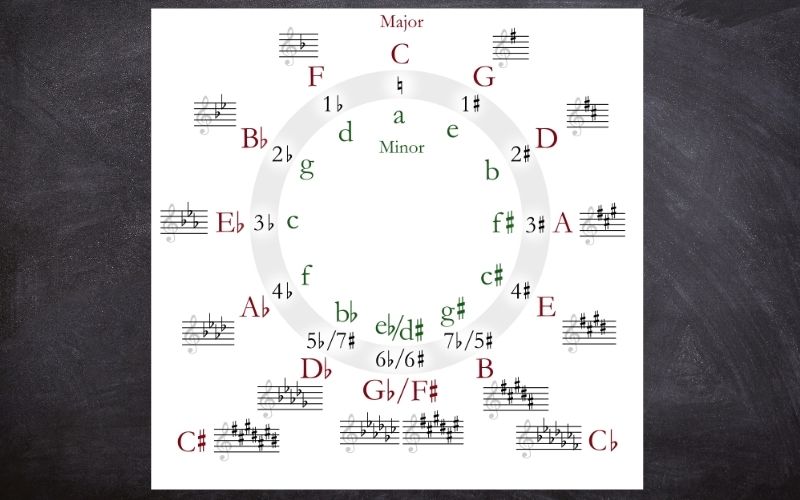
The circle of fifths is one way that you can choose what key you’re going to work in, but if you’re a beginner, I say to use A Minor or C Major. I wrote in my lo-fi tutorial that C Major and A Minor were the most commonly used key signatures in music, and the same goes for songs composed on the piano.
The reason for that, I believe, is that there are no accidentals in A Minor and C Major, and they are the relative minor and majors of each other. This means they’re easy to play, especially on the keyboard, where all of the accidentals are represented by black keys, and then all the natural notes are represented by the white keys.
This is one thing that you’ll learn from PianoForAll which is a great way to start on the piano, particularly if you’re trying to learn the piano for music production which is something I talked about in my article on this very topic.
So if you take a look at C Major and A Minor on the chart above, you’ll notice there are no accidentals underneath where it says “C” and then “a minor.” There is just the natural symbol which indicates there are no sharps or flats.
So the notes of C Major are: C, D, E, F, G, A, B, and C again
And then because A Minor is the relative minor, that means you’re using the same notes but starting from the A instead so it’ll look like this: A, B, C, D, E, F, G, and A again.
Here’s how to play all the chords of the A Minor Scale on piano:
2) Pick A Chord Progression That Uses Minor and Major 7th and 9th Chords
If you’ll recall my article on songwriting tips for beginners, you’ll know that I have a big list of chord progressions that you can use for your own songs. That’s a really helpful article to read if you’re trying to figure out how to make your own songs. Here’s another short list of progressions specifically for lo-fi that you can experiment with.
Common Lo-Fi Chord Progressions
| Lo-Fi Chord Progressions in Roman Numerals | Chords |
| VI-v-i-VII-i | F, Em, Am, G and Am |
| iii-V-ii-I | C♯m, E, B and A |
| iv-♭VII⁷-I | Dm, Bb7, C |
| I-V-IV-vi | C, G, F, and Am |
| i-iv-i-bii-viio7 | Cmin11, Fmin7, Cmin11, Dbmin11, B#dim7 |
| i-ii | Cmin11 and Dm11 |
Each of the progressions listed above can be added to or modified in any way that you choose. For example, you could make all major chords major 9th or major 7th chords, or you could make the minor chords minor 11 chords instead of just standard triads.
When I was preparing this list of lo-fi chord progressions, I jammed on the “iii-V-ii-I” for a long time because I found that by playing those same chords but in different ways and also adding the 7th, 11th, or 9th to them, I was able to bring the progression to life.
It’s worth mentioning that these chords are really easy to find on the internet if you’re unsure how to modify them. I’ll show you how I wound up using the “iii-V-ii-I” progression later in the article – I’m stoked about how it turned out.
3) Choose An Ambient or Soundscape Piano Along With a Retro Piano
Some of the Best Lo-Fi Piano Instruments
One of the better ways to go about making music is to first have an idea of what kind of instrument inspires you the most. And this goes for any type of music you’re working on. If you don’t like the instruments that you’re working with, it’s going to be hard to find that creative energy.
Don’t worry, I’ve got you covered because there are some great-sounding pianos that will help you feel inspired to create lo-fi beats.
Spitfire Audio LABS’ Soft Piano
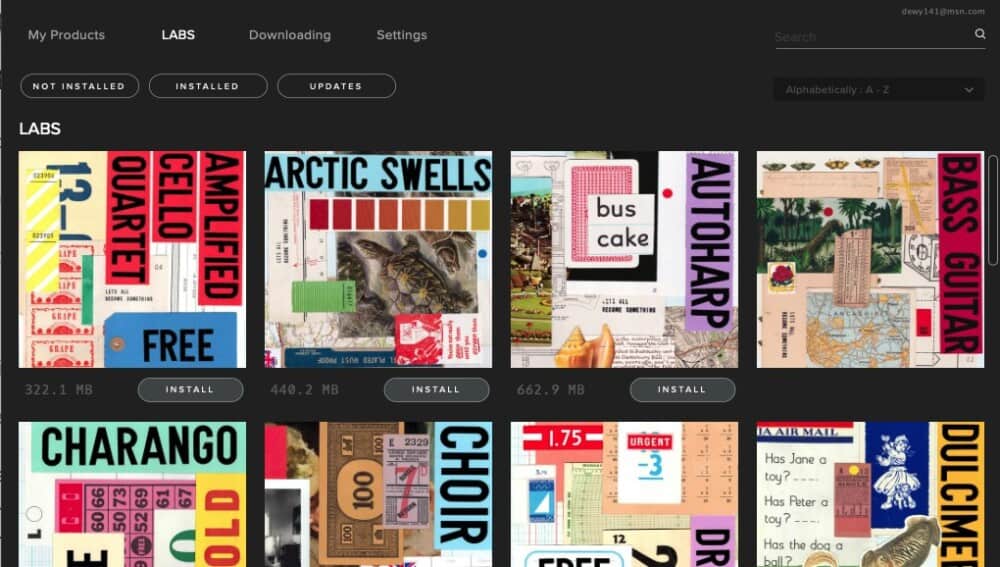
Spitfire Audio’s LABS is probably one of the greatest free plugins that you could ever get your hands on – and this is something I’ve said before in my best plugins for GarageBand article. The reason why I’m always harping on LABS is that all of the instruments you get for free sound amazing. The quality is high and they just inspire you to create.
When you download LABS, you gain access to not only the soft piano which is one of my favorites to use to this day, but many others as well including the Peel Guitar, the Moon Guitar, the Autoharp, and the Strings VST too.
Garageband’s Processed Piano Section
Every DAW has its own instruments and sounds but I find that Garageband’s Processed Pianos sound very good for making Lo-Fi music, particularly the ones that just came with their latest update. You can see what that looks like here:
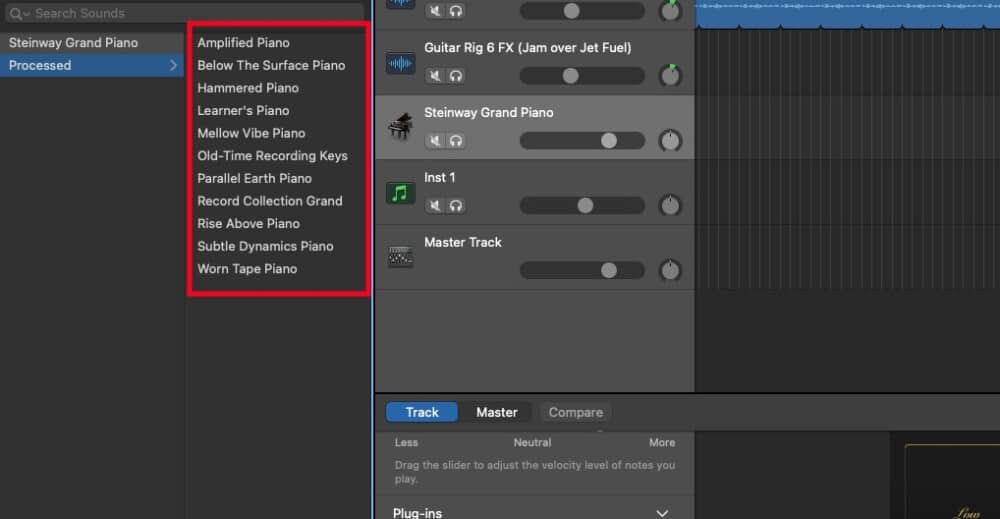
The Steinway grand piano doesn’t sound that bad either, but I prefer others like the Old-Time Recording Keys which screams “lo-fi.” Many plugin bundles come with these lo-fi-sounding pianos as well including Komplete 13, Komplete Start, and XPand!2 which we’ll talk about in a second.
Komplete 13’s Hybrid Keys (and More)
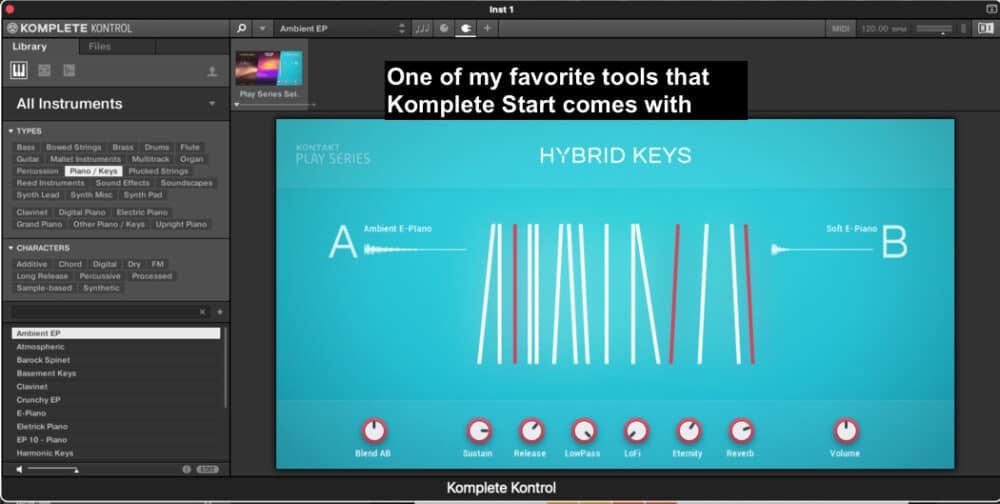
Komplete 13 (and Komplete Start – the free version) come with a whole host of instruments, sounds, samples, and VSTs that are worth their own article entirely, but there is no shortage of great-sounding pianos sounds in Komplete 13.
Komplete Start, which is the demo version and you can find it on their website here, has Hybrid Keys as well so you’re in luck if you want to try it out for free.
Hybrid Keys is more than just one sound as well. It’s a sample library that features many different keyboards, piano, and mixed piano/keyboard sounds. When I first got Komplete Start a few years ago, I made a video on my YouTube channel which you can check out here. I even demoed the Hybrid Keys and got a bit distracted by it because it sounded so good.
Komplete 13 features more than just one piano instrument too. There are another 6 different piano VST libraries including Noire, Una Corda, The Maverick, The Giant, The Grandeur, and the Gentleman. You can see what that looks like here:
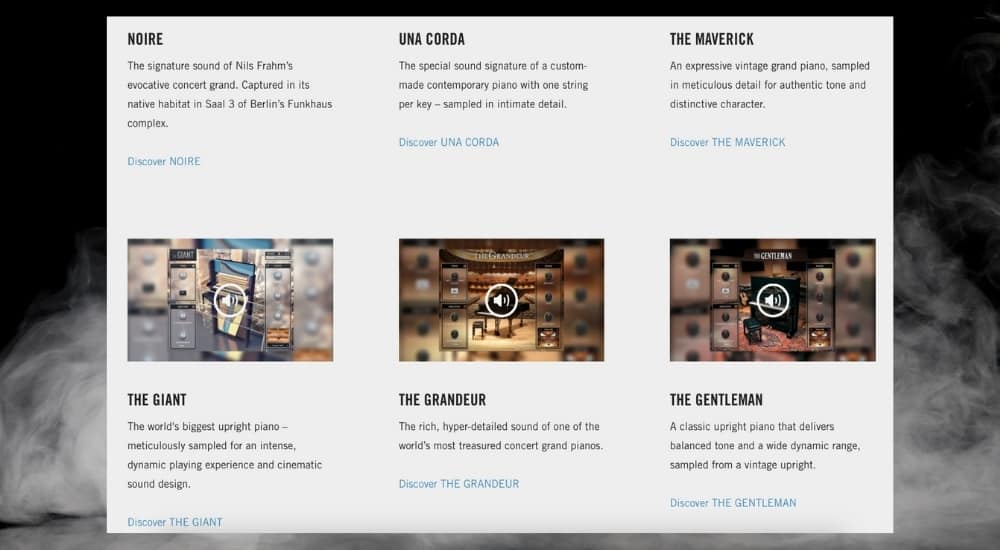
Air Music Tech’s XPand!2 (Acoustic Piano, Electric Piano, and Organs)
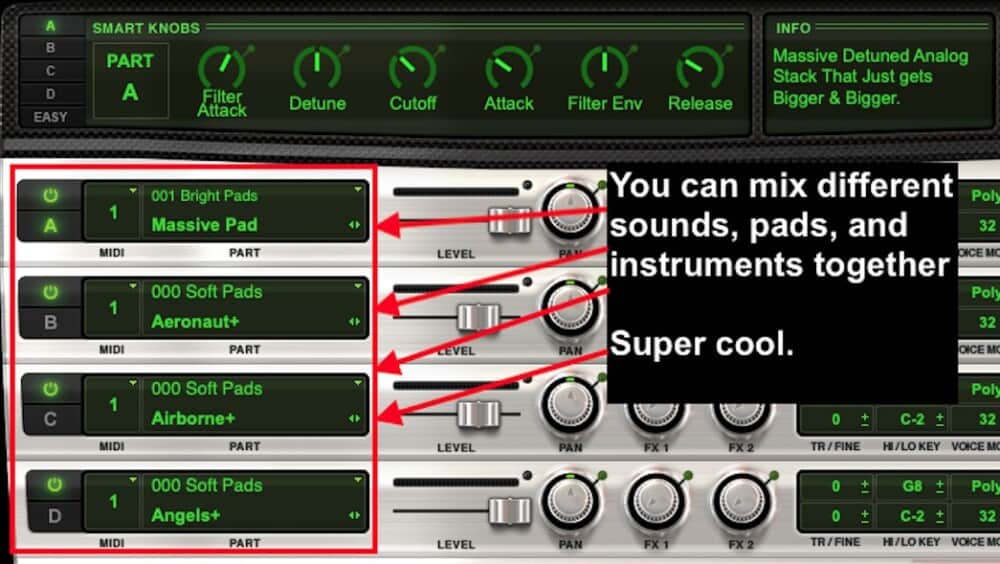
XPand!2 from Air Music Tech, which is probably the most popular multi-instrument plugins (and one of the cheapest too), features a plethora of instruments and soundscapes in the same way that Komplete 13 does.
However, Komplete 13 is a premium software package that comes with everything you would ever need, whereas XPand!2 is a quick and dirty way of getting great sounds. I own both of them so I’m not knocking it. XPand!2 is great and it’s inexpensive.

And again, like Komplete 13, there is a lot to work with here with XPand!2 because not only can you mix and match sounds together like the image above shows you, but there are also dozens of instruments within the three main piano categories which are Acoustic Pianos, Electric Pianos, and Organs.
Komplete 13 and Komplete Start, XPand!2, Garageband’s Processed Pianos, and Spitfire Audio’s Soft Piano are just a few of the piano sounds that you can find for your DAW. There is a lot more to find out there especially if you’re willing to get just one sound.
I prefer getting plugins like this in bundles though, because you get a ton of instruments and sounds within each one, rather than just one piano sound. Some of the other pianos you can get for your lo-fi tracks include Spectrasonics’ Keyscapes, the 4Front Piano, and the list can go on.
Piano Chords That Sound Good in Lo-Fi Music
The pianos I just listed should give you a nice boost in creativity and inspiration, but the new plugin-high doesn’t last long, as many producers know. Once you’ve gotten over it, you’ll probably be looking to find some chords that sound good in lo-fi music.
The chord progressions that I listed earlier is a great place to start, however, I listed them down here separately as their own thing. Understand that these chords can be from any key, rather than just C Major, for instance, you could have a BbMaj7, an Amin9, or a Bmin11, just to name a few.
| Chords | Notes |
| CMaj7 | C E G B |
| CMaj7add9 | C E G B D |
| Cmaj7/13 | C E G B A |
| Cmin7 | C Eb G Bb |
| Cmin9 | C Eb G D |
| Cmin7/11 | C Eb G Bb F |
| Csus2 | C D G |
| Csus4 | C F G |
Taken from my article on making a lo-fi beat in Garageband
What chords you use in your lo-fi track depends on what sounds you actually like, but I find the ones I’ve listed above sound the best. Some chords you may want to add to that includes the Dominant 7th chord, for example, like the C7 chord, the Diminished 7th chord, or maybe even a major 6th chord.
| Chords | Notes |
| C7 | C E G Bb |
| Cdim7 | C Eb Gb A |
| Cmaj6 | C E G A |
The key thing you want to experiment with though is using extended or added chords rather than just simple triads like a Major or Minor triad with only three notes.
Maj7 and Min7 chords, in particular, tend to sound the best in lo-fi music because the minor 7th has the Dorian feel whereas the Major 7th has the Lydian feel which is more dreamy.
I’ve talked all about this in my aesthetic track tutorial which is very similar to how you would go about making lo-fi music, so make sure to check that out. The chords I’ve outlined above are shown down in the video here so take a look at that too.
Another thing that you can do is you can actually Google Lo-Fi chord progression and you may find yourself coming up with some great ideas that way as well. For instance, this YouTube video from Landr features eight different progressions that sound great in the lo-fi beat context.
4) Play the Chords As Triads or Arpeggios
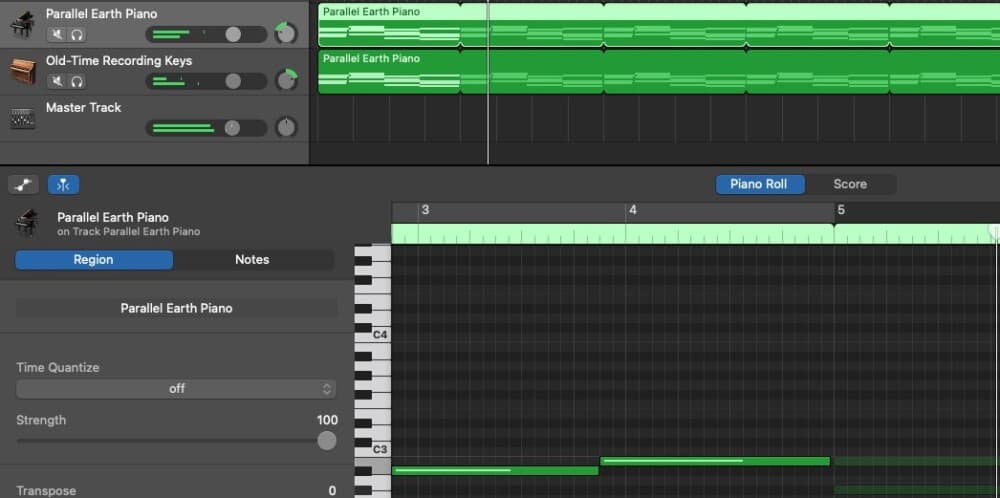
For the instruments, I chose the Parallel Earth and the Old-Time Recording Keys which both come from Garageband’s processed piano section. These are new pianos, and they really sound great, particularly when paired together.
The Old-Time Recording Keys on its own was maybe a little too much lo-fi whereas the Parallel Earth was too warm to be on its own.
How you play the chords is up to you, but I find that when it comes to making lo-fi music (or really any music for that matter), sometimes the chords by themselves are enough. You can choose to play them melodically, that is to say, one-by-one in succession, or harmonically – all together at once.
For the sake of this tutorial, I use the following “iii-V-ii-I” progression which I think sounds amazing, especially when you take the advice that I just gave and use extended chords. One could take it even a step further and use 1st and 2nd inversions to really get this progression to shine.
iii-V-ii-I : C♯m, E, B and A
So this is one of the progressions that I showed you earlier, but here’s how I modified it to make it sound much cooler:
C#min7 – Emaj6 – Bmaj7 – Aadd9
In the piano roll, it looks like this:
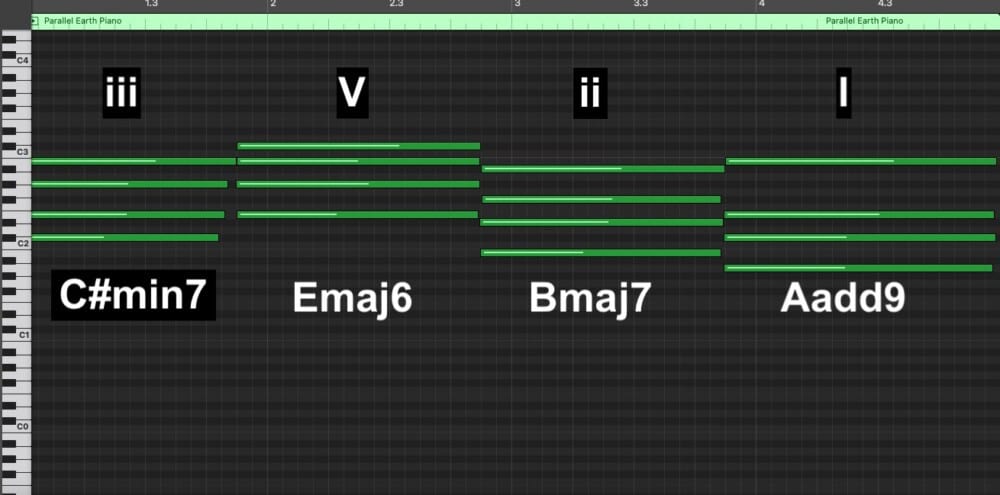
C#min7 = C#-E-G#-B
Emaj6 = E-G#-B-C#
Bmaj7 = B-D#-F#-A#
Aadd9 = A-C#-E-B
You can hear what that sounds like in the video below:
And that’s all I did to make a lo-fi piano melody.
Pro-Tip:
The difference between a chord like Emaj6 and a chord that says Aadd9 is that the “maj” designates that there is a major 6th interval in the chord, in contrast to the Aadd9, where the “add9” means there is just the 9th degree of the scale, with A as the root, in the chord.
General Principles of Songwriting and Lo-Fi
Like I stated in my article on how to make lo-fi music in Garageband, from what I understand about making music using my own experience and listening to that of others, most people start out just by jamming on a chord or a pre-existing idea of some kind, rather than just taking a look at a scale and picking chords from it.
While there may be times when you find yourself looking to music theory to help you make a decision, for the most part, musicians will fumble around with an idea until they come up with something that sounds good to their ears.
For instance, whenever I come up with something new, it’s usually done when I’m practicing or learning a new song.
This exact thing happened to me recently while I was going through PianoForAll which I’ve found is probably one of the better ways to get accustomed to playing the piano (and also the cheapest if you get it from their site).
Additionally, I’ll often create a new song while I’m listening to music that I find inspiring. However, lately, if I’m playing with an idea, I’ll usually find what key I’m in, what scale I’m using, and then I’ll write down the chords that fit in that scale as well as their arpeggios.
What this does is that it gives me an idea of where I can go with some of the melodies that I already have. Let’s not dwell on this more esoteric and abstract discussion though. It would be better if we talk about some of the elements of lo-fi music.
Commonly Used Elements of Lo-Fi Music
The aforementioned elements aren’t in every lo-fi song, but they are fairly common and you’ll at least find a majority of them in each track. I listed these elements before in my lo-fi tutorial, and they are the following:
1) An ambient, spacious, chill, or sweet vibe
2) Often Has No Vocals (but not always)
3) Jazzy instruments and ambient soundscapes
4) Warmer Sound Achieved Through More Lower Range Frequencies
5) Vinyl Popping, Cassette Hissing, and Other Analog Sounds
6) Samples from the 1950s, ’60s, ’70s, ’80s
7) The Song is Usually Slow (70-100 BPM)
Important Things to Note About Making A Lo-Fi Piano Melody
1) The Instruments You Use Are Of Crucial Importance
If you’ll recall what I said earlier, what makes a lo-fi piano sound like “lo-fi” is commonly the instrument itself in conjunction with the way the chord progression sounds in terms of its tonality.
For example, a simple I-VI progression on the grand piano will just sound like a basic 2-chord progression, but with the Resonant and Ambient Piano which comes as part of XPand!2, for example, you’ll have something that sounds a lot more lo-fi.
Moreover, by adding something like the sounds of vinyl popping in the background, you can increase the “lo-fi-ness” of the song.
To drive the point of home, if you think about playing the I-VI chord progression on the electric guitar with lots of distortion and gain, it’ll sound like metal or hard rock, but on a soft piano alongside a synth, it’ll sound more like lo-fi. That’s something that’s worth keeping in mind.


 Written By :
Written By : 